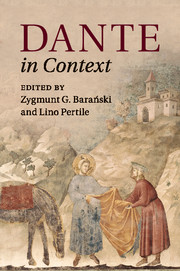Book contents
- Frontmatter
- Dedication
- Contents
- List of illustrations
- List of maps
- Notes on contributors
- Chronology
- Abbreviations and note on translations
- Introduction
- Part I Politics and society
- Part II Intellectual traditions
- Part III Linguistic and literary cultures
- 15 Linguistic Italy
- 16 Education
- 17 Rhetoric, literary theory, and practical criticism
- 18 Classical antiquity
- 19 Religious culture
- 20 Visions and journeys
- 21 Historical and political writing
- 22 Vernacular literatures
- 23 Popular culture
- Part IV Visual and performative culture
- Part V Dante: life, works, and reception
- Further reading
- Index
19 - Religious culture
from Part III - Linguistic and literary cultures
Published online by Cambridge University Press: 05 October 2015
- Frontmatter
- Dedication
- Contents
- List of illustrations
- List of maps
- Notes on contributors
- Chronology
- Abbreviations and note on translations
- Introduction
- Part I Politics and society
- Part II Intellectual traditions
- Part III Linguistic and literary cultures
- 15 Linguistic Italy
- 16 Education
- 17 Rhetoric, literary theory, and practical criticism
- 18 Classical antiquity
- 19 Religious culture
- 20 Visions and journeys
- 21 Historical and political writing
- 22 Vernacular literatures
- 23 Popular culture
- Part IV Visual and performative culture
- Part V Dante: life, works, and reception
- Further reading
- Index
Summary
Even today, more than seven hundred years after the historical purview of this volume, a visit to any of the cities where Dante lived affords a sense of the pervasive religious character of the poet's culture. Cathedral, free-standing baptistery, the massive churches of the monastic orders along with the monasteries themselves, smaller parish churches, tiny neighbourhood chapels, street-corner shrines: all bear witness to a spiritual matrix that once undergirded every aspect of the medieval city's life. Although some of these structures continue to serve the religious needs of the present community, inevitably many have been repurposed as museums, schools, police headquarters, hospitals, or shops. Even those still functioning, however, have fallen victim to global tourism and the consumer ethos it encourages: churches are sights to be seen and photographed as much as houses of worship. It takes an effort, therefore, for a predominantly secular twenty-first-century person to enter into a world so completely shaped by Catholic religion, or to imagine, more specifically, how a late-thirteenth-century layman like Dante might have been formed as a believer.
The Christian life
Such an imaginative reconstruction might well begin with the Christian rite of initiation, baptism, which in the Florence of Dante's day was a large public affair held on Holy Saturday, the eve or vigil of Easter, in the communal baptistery dedicated to St John the Baptist, one of the city's patrons. Godparents were trained weeks ahead of time to impart to their wards the essentials of Catholic faith and practice: the Paternoster, the Ave Maria, the Salve Regina, and the Apostles' Creed. The infants were exorcised, signed with the cross on their foreheads, and breathed on by the priest in an invocation of the Holy Spirit. At the baptism itself, in the presence of parents and godparents, priests immersed the children in assembly-line fashion, and in water that had been blessed by the bishop. (The same water would be used for baptisms held later in the year, either at a mass observance at Pentecost or privately, at any time, if the infant was in danger of death.) Immediately afterwards, the newly baptized were given another sacrament, confirmation, and anointed with holy oil (chrism) as the sign of the cross was made on the forehead.
- Type
- Chapter
- Information
- Dante in Context , pp. 319 - 340Publisher: Cambridge University PressPrint publication year: 2015

